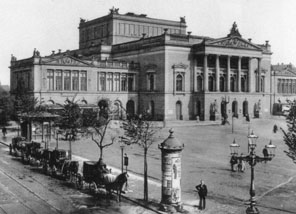Context, Creation & Origin
Context of Mahler's Symphony 1

The Leipzig Opera House where Mahler was working during the creation of his First Symphony.
Mahler’s first symphony was composed while he was working as second conductor at the Leipzig City Theatre where he worked from August 1886 to May 1888. Mahler’s work at the theatre during this period was often overshadowed by the great public success achieved by rival principal conductor Arthur Nikisch. Despite this, Mahler accomplished widespread recognition through his arrangement and completion of Carl Maria von Weber’s opera: Die drei Pintos (The Three Pintos), which was premiered on January 20 1888 in front of an influential audience including the Russian composer Tchaikovsky and the heads of various international opera houses looking to acquire rights to perform the work. Indeed, the opera soon went on to be performed in Hamburg, Munich, Dresden, Kassel and Vienna.
The success of Die drei Pintos earned Mahler large financial rewards and significantly raised his public profile which provided Mahler with the impetus he needed to begin the creation of his first symphony.
When symphony written:
Although there is conflicting evidence regarding the period in which Mahler wrote his first symphony, the following resources suggest that he composed the majority of the work in an intense creative burst between the 20th January and the end of March 1888.
According to Natalie Bauer-Lechner: "Mahler composed the whole symphony in Leipzig in the space of six weeks in addition to conducting and rehearsing constantly; he worked in the morning from the time he got up until 10 o’clock, and in the evenings whenever he was free."
This information is corroborated by Mahler in a letter written to his friend Fritz Löhr informing him of the completion of the work: "It became so overpowering as it flowed out of me like a mountain river!... for six weeks I had nothing but my desk in front of me!"
Max Steinitzer, a notable Richard Strauss biographer and acquaintance of Mahler’s wrote that he entered a period of "almost feverish composing" after arranging Die drei Pintos.
Incorporating previous works:
Mahler’s early symphony’s often incorporate musical ideas based on pre-existing works written by himself and other composers. The first symphony provides an extreme example of this, with music being either closely inspired by, or extracted from the following works:
- Mahler’s Lieder eines fahrenden Gesellen ('Songs of a Wayfarer');
- Mahler’s Der Trompeter von Säkkingen ("The Trumpeter from Säkkingen");
- Mahler’s Hans und Grethe ("Hansel and Gretel");
- Bruder Martin ("Brother Martin, Are You Sleeping?") folk song;
- Liszt's Dante Symphony;
- Wagner's Parsifal
Mahler once wrote to Natalie Bauer-Lechner:
"composing is like playing with building blocks, where new buildings are created again and again, using the same blocks. Indeed, these blocks have been there, ready to be used, since childhood, the only time that is designed for gathering."
There are distinct connections between Mahler’s first symphony and his previously written Lieder eines fahrenden Gesellen ('Songs of a Wayfarer'), his first song cycle completed in 1885. The main theme, forming the basis of the opening movement of the symphony, originated from the theme found in the second song from the cycle:![]()
(MP3 Format)
The final verse from the fourth song in the cycle features in the middle section of the funeral march from the symphony, providing an introspective interruption.
The ‘Blumine’ movement, originally the second movement of the symphony, was derived from the incidental music Mahler wrote for Joseph Victor von Scheffel’s play Der Trompeter von Säkkingen ("The Trumpeter of Säkkingen"), which he composed "within two days" during June 1884.
The Scherzo movement uses motifs from Mahler’s Hans and Grethe song written in 1880.
The theme for the third movement titled Totenmarsch in Callots Manier (Funeral March in Callot's manner) is based on the famous melody from the student round Bruder Martin ("Brother Martin, Are You Sleeping?" also known as Frère Jacques):

(MP3 Format)
Mahler borrowed motifs from Franz Liszt’s Dante Symphony written in 1856, and Richard Wagner’s Parsifal written in 1882, two composers whom Mahler respected dearly.